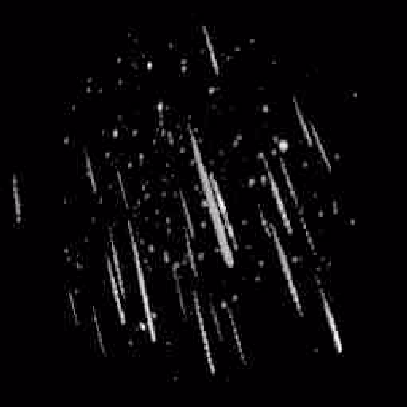Explanation: From a radiant point in the constellation of Perseus, Comet Swift-Tuttle presents -- The Perseid Meteor Shower -- coming to your night sky this weekend! A bookish E. C. Herrick of New Haven, Connecticut correctly suspected in 1837 that this meteor shower was an annual event. Indeed it is now known to be a regular August shower caused by the yearly passage of the Earth through the orbiting debri left behind by periodic comet Swift-Tuttle. Since the bits of comet debri are moving along parallel orbits, on entering the atmosphere they leave fiery trails which appear to originate from a common radiant point in the sky, in this case in the constellation of Perseus. Dramatically illustrated in this composite video image made using MOVIE, meteors from the 1994 Perseids streak across the sky framed by the three bright stars of the asterism known as the "Summer Triangle". The image shows bright Perseids recorded that year from August 9 through 14. Here the trails appear nearly parallel as the camera was centered on the sky about 90 degrees from the radiant point. This year, European and North American observers should be able to view the shower near its maximum, about 90 meteors per hour, early Monday morning August 12, but the shower should be enjoyable on clear weekend nights (August 10,11) as well. After midnight is generally the best time for viewing. What's the best way to enjoy a meteor shower? Get a warm jacket and a comfortable lawnchair ... go outside and look up.
1999 2000 2001 2002 2003 2004 2005 2006 2007 2008 2009 2010 2011 2012 2013 2014 2015 2016 2017 2018 2019 2020 2021 2022 2023 2024 2025 |
Yanvar' Fevral' Mart Aprel' Mai Iyun' Iyul' Avgust Sentyabr' Oktyabr' Noyabr' Dekabr' |
NASA Web Site Statements, Warnings, and Disclaimers
NASA Official: Jay Norris. Specific rights apply.
A service of: LHEA at NASA / GSFC
& Michigan Tech. U.
|
Publikacii s klyuchevymi slovami:
Perseidy - radiant - Meteor
Publikacii so slovami: Perseidy - radiant - Meteor | |
Sm. takzhe:
Vse publikacii na tu zhe temu >> | |
